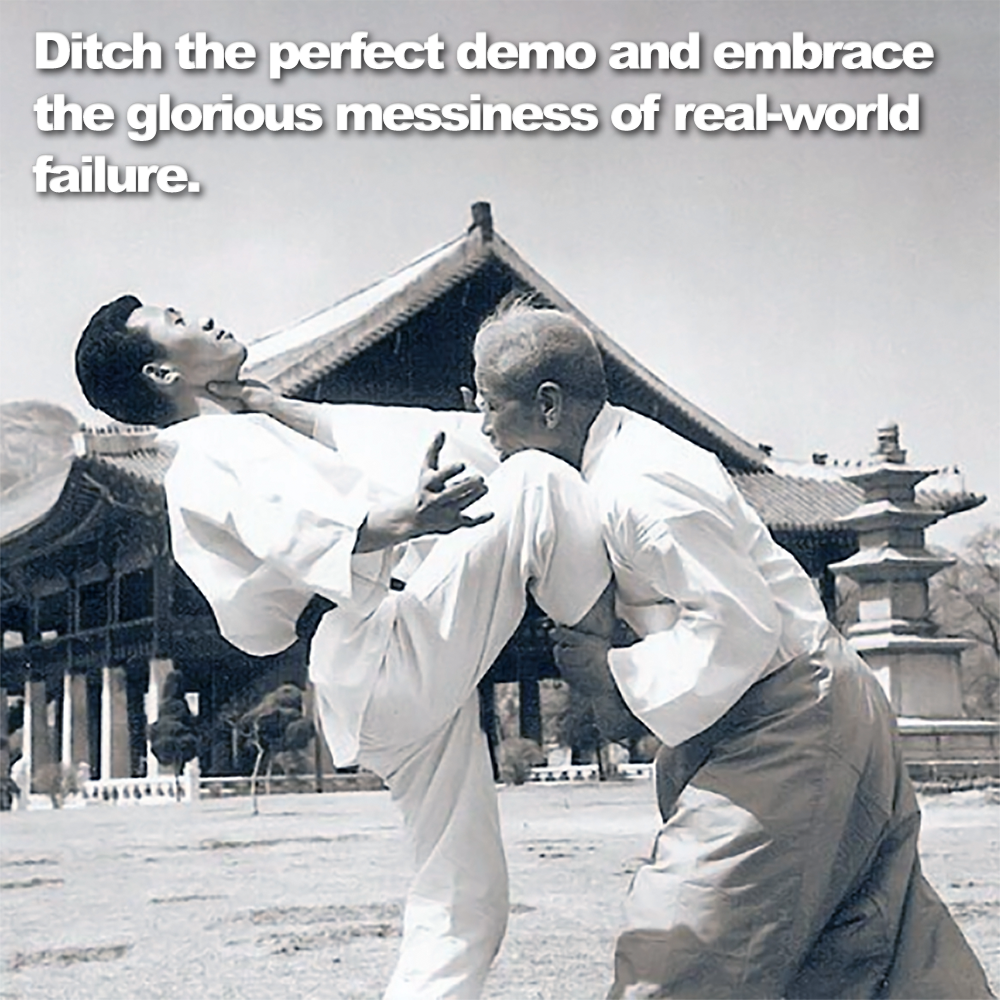
Ditch the perfect demo and embrace the glorious messiness of real-world failure.
Posted by ADAM CARTER on MAR 26, 2024

Ditch the perfect demo and embrace the glorious messiness of real-world failure.
(2 minute 13 second read)
The martial arts require demonstration to supplement the whole teaching process. I get it. I demonstrate to my students. However, I always incorporate some level of failure into my demonstrations.
Why? Because a real life attack is unpredictable, chaotic, vicious, and brutal. Your techniques will probably not go as planned and you may have to ‘reset’ from a failed attack and try to retake the initiative.
We all know the drill: watch the instructor flawlessly demonstrate a technique, then try to mimic it. But here’s the thing: real life throws a wrench into those perfectly timed defenses.
If you find yourself having to fight your way out of trouble, a real-world confrontation is about as graceful as a runaway shopping cart. It’s unpredictable, messy, and, let’s be honest, kind of terrifying.
Your perfectly practiced techniques might not land exactly as planned. That’s when you need to be able to ‘reset’, adapt, and take back control.
Those picture-perfect demonstrations, can lull you into thinking you can predict every attack and counter-attack. Spoiler alert: you can’t. In a real fight, just defending yourself against the first blow is a victory. And this is a major problem when using karate type attacks for self-defense scenarios….. You know what’s coming!
A demonstration with the ever-so-compliant partner, they’re great for learning the basic mechanics, but they can create a false sense of security.
The truth is, a real attacker won’t just stand there waiting for your perfect defense. So include in your practice pressure testing; unknown wild attacks, pushing, pulling, grabbing, verbal escalation, spitting and more.
The effectiveness of any technique depends heavily on knowing the attack beforehand, which, you guessed it, never happens in the real world.
Demonstrations shouldn’t shy away from showing what happens when things fall apart. We’ve all seen those slick techniques that gloss over the possibility of failure. But assuming your opponent will just cooperate with you is a recipe for disaster.
We can try to predict likely responses, but there are no guaranteed ones. Imagine landing a punch to an attackers gut – your opponent might react in a predictable way, but there’s always a chance they’ll surprise you.
That’s why demonstrations need to consider the natural human ‘flinch response’ that can throw a perfectly planned technique off-kilter.
The real test comes when things go sideways (and they will!). That’s when you need to be able to adapt to failure and situations that don’t go according to plan.
Your attacker will react to your movements, your techniques, so demonstrations should show what happens when they’re not conveniently positioned for your next technique.
The best demonstrations acknowledge the possibility of failure and train students to be adaptable. Focusing solely on flawless execution in a controlled setting creates unrealistic expectations and leaves you unprepared for the real world.
Ironically, in most schools, compliance is often seen as “being a good partner” but the very opposite is true.
Your training may fail you in a variety of ways in real life. An awareness of why this may happen goes a long way to making sure it doesn’t.
So, ditch the perfect demo and embrace the glorious messiness of real-world failure.
